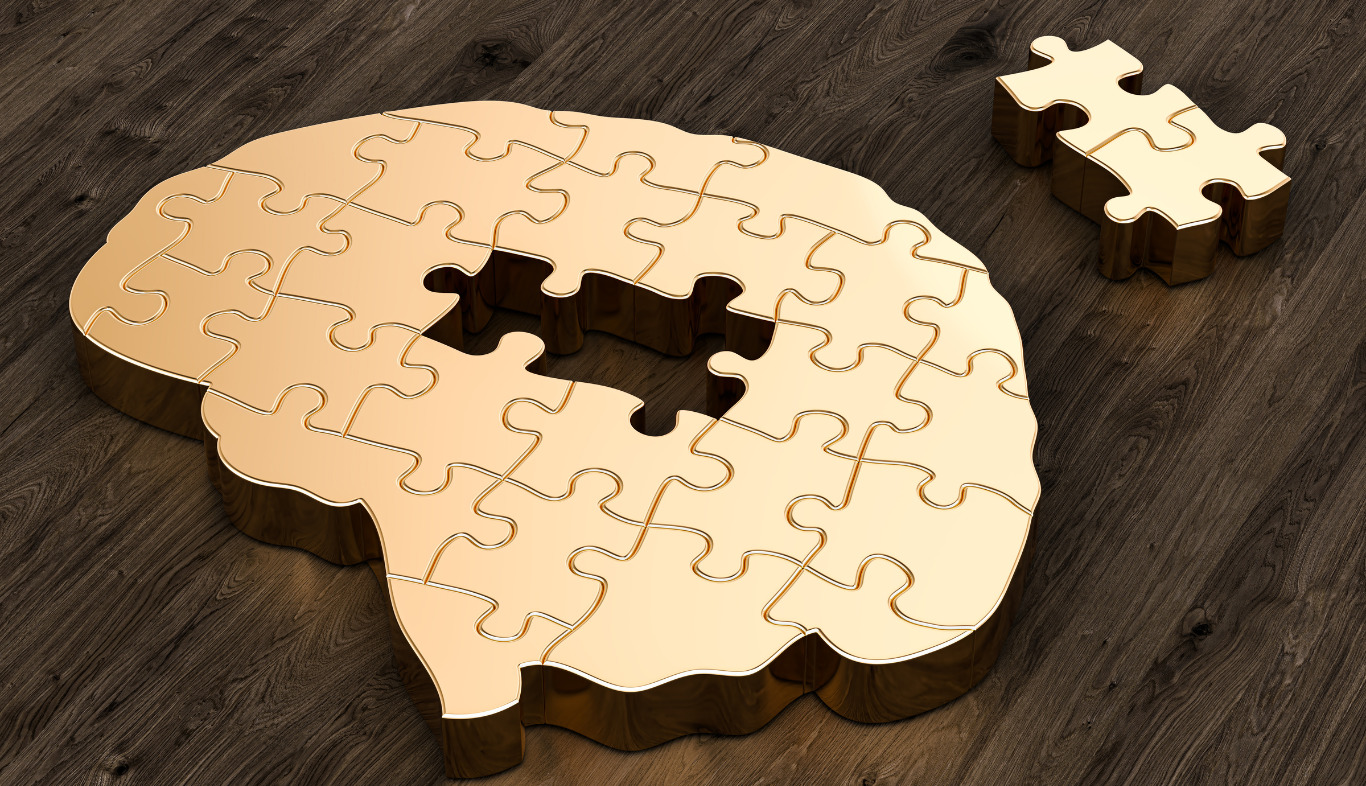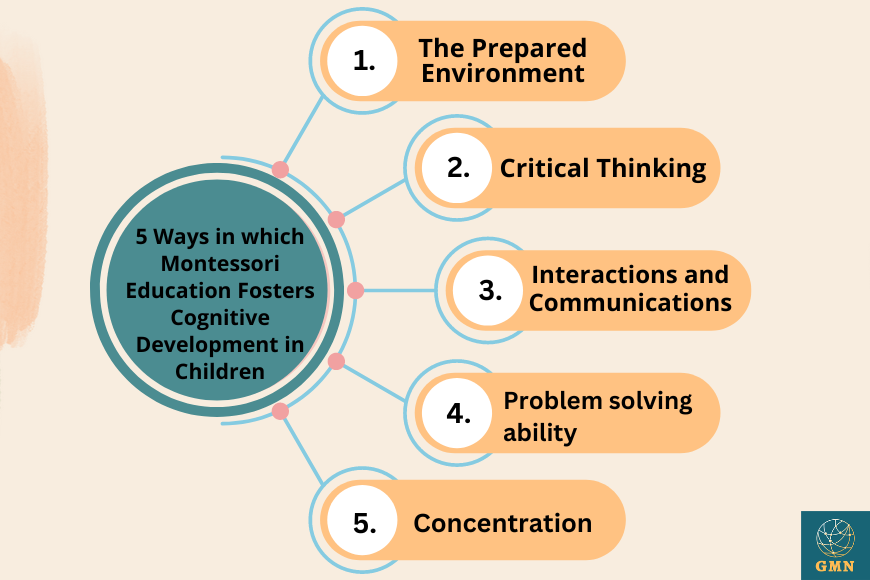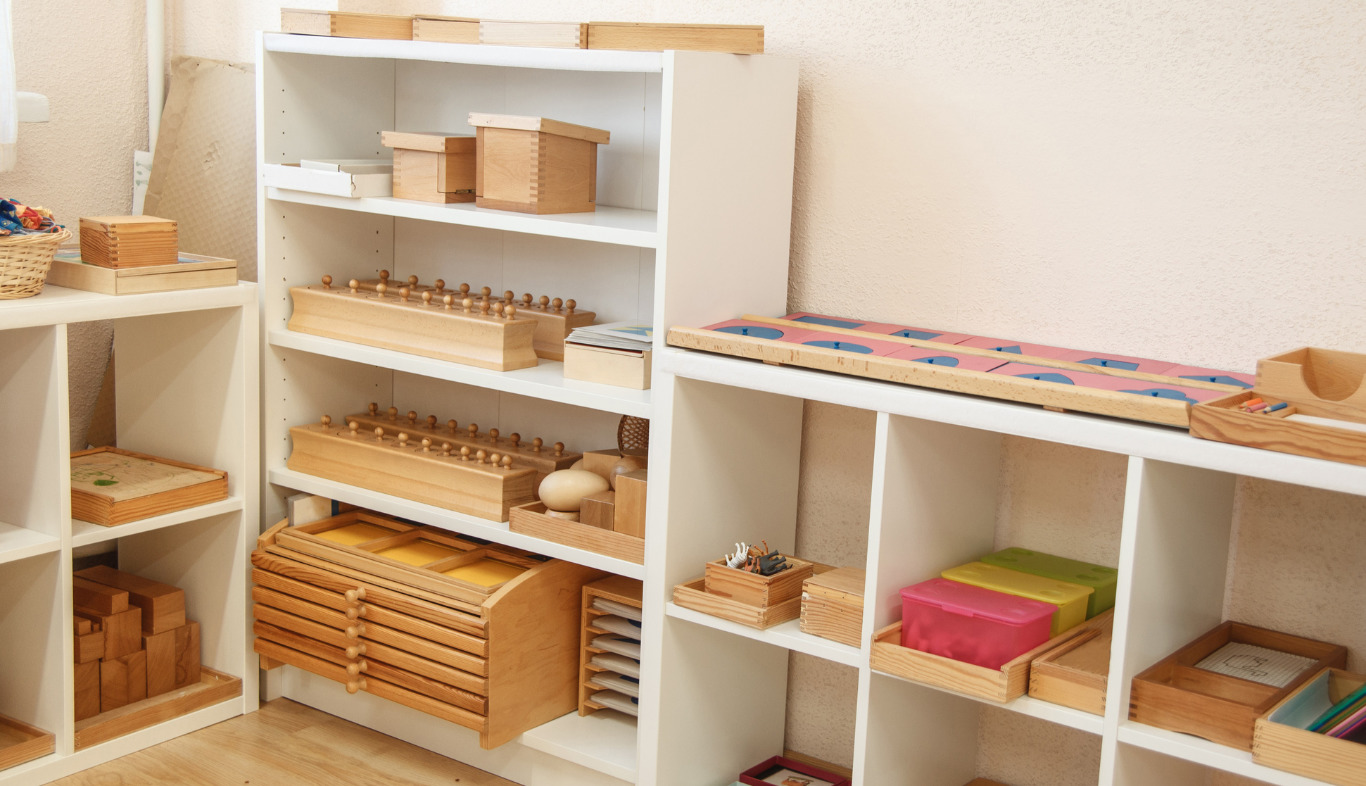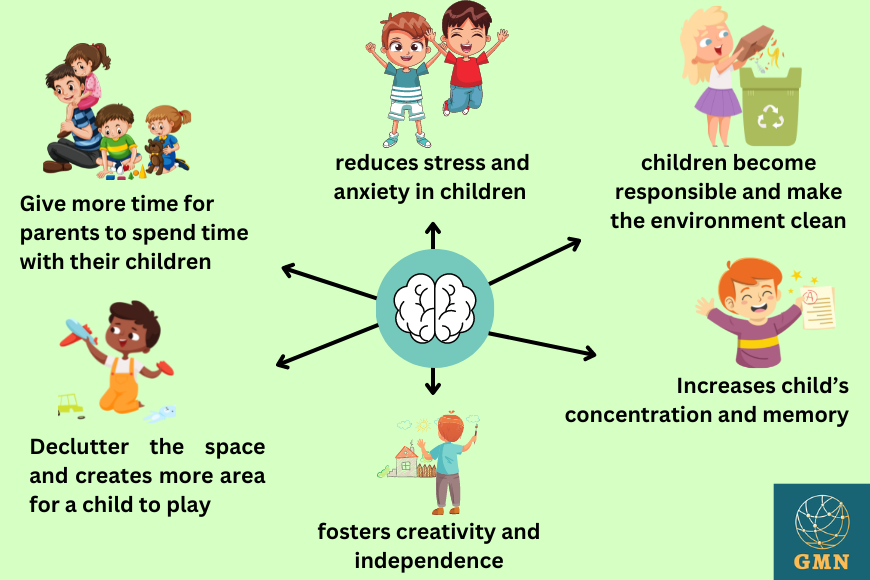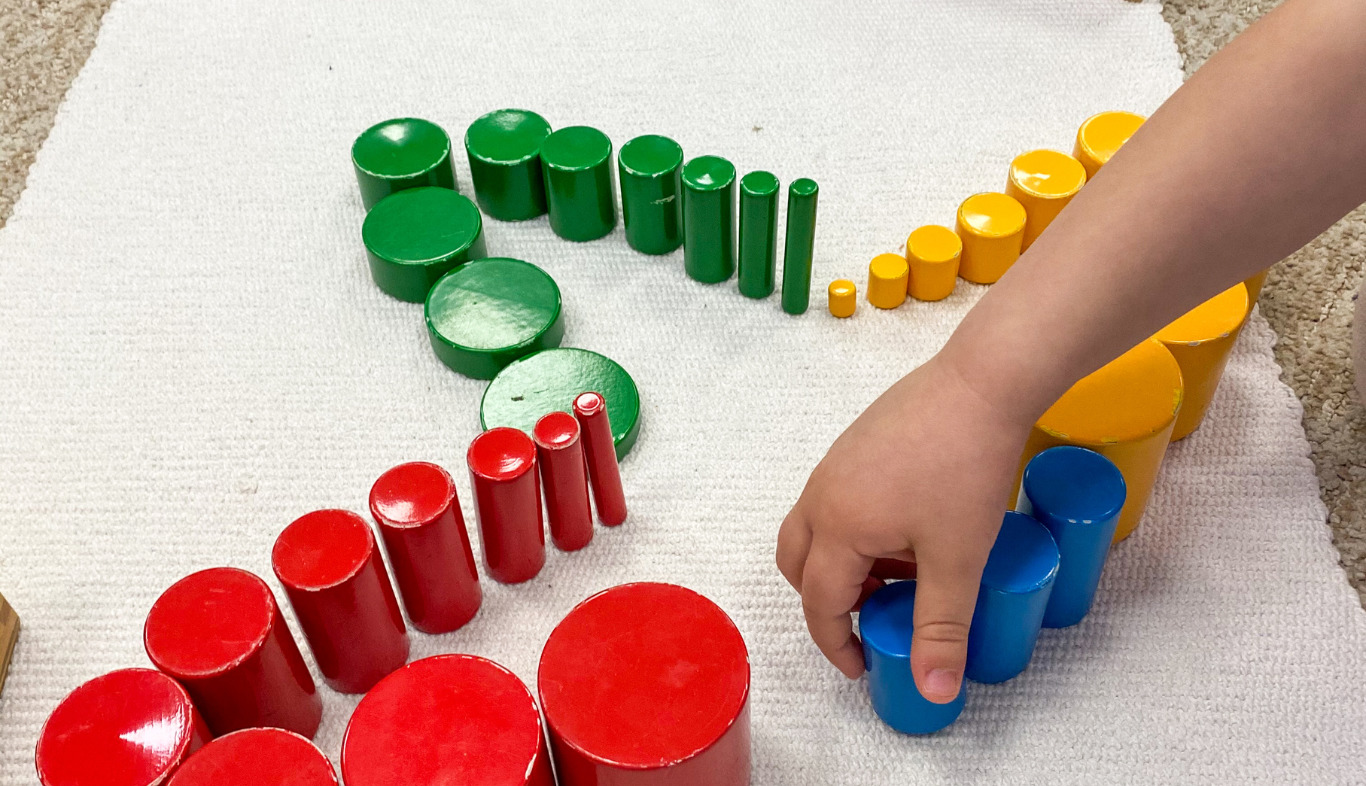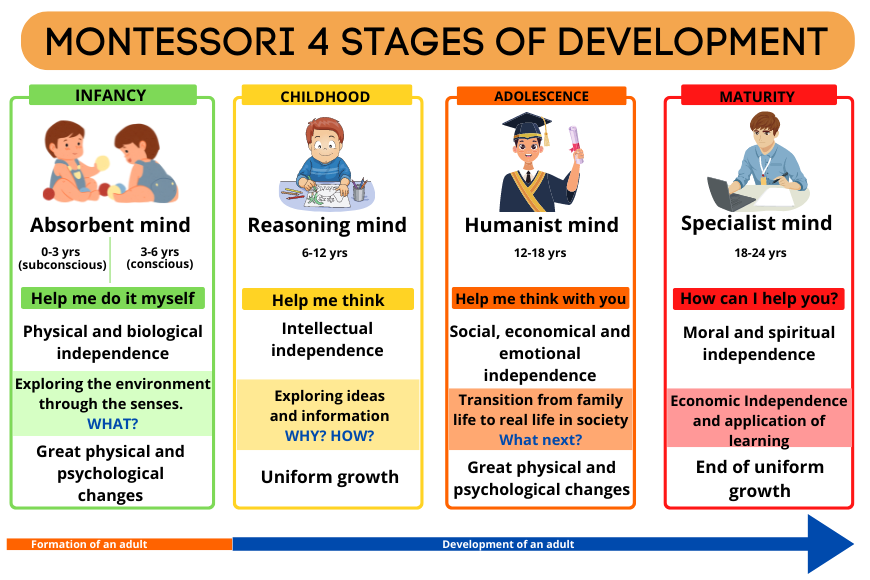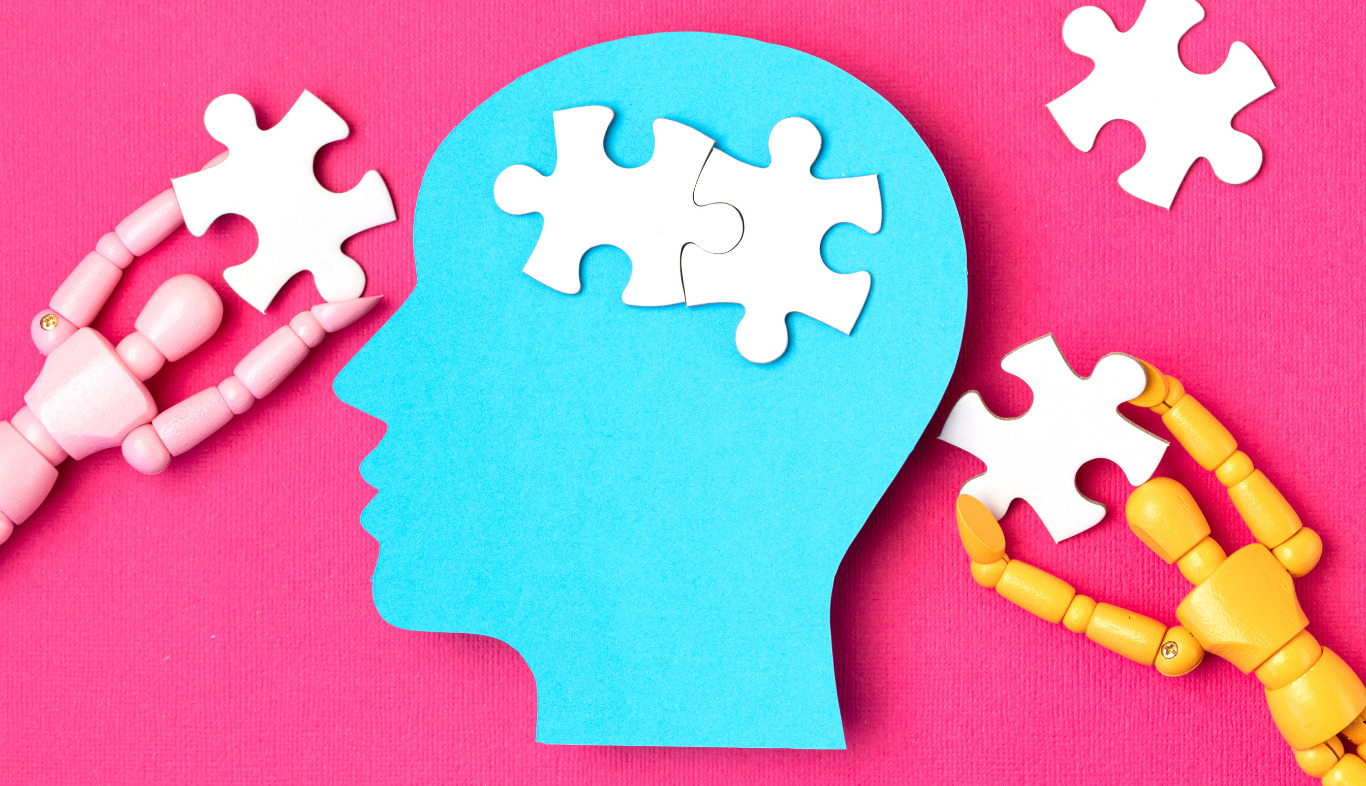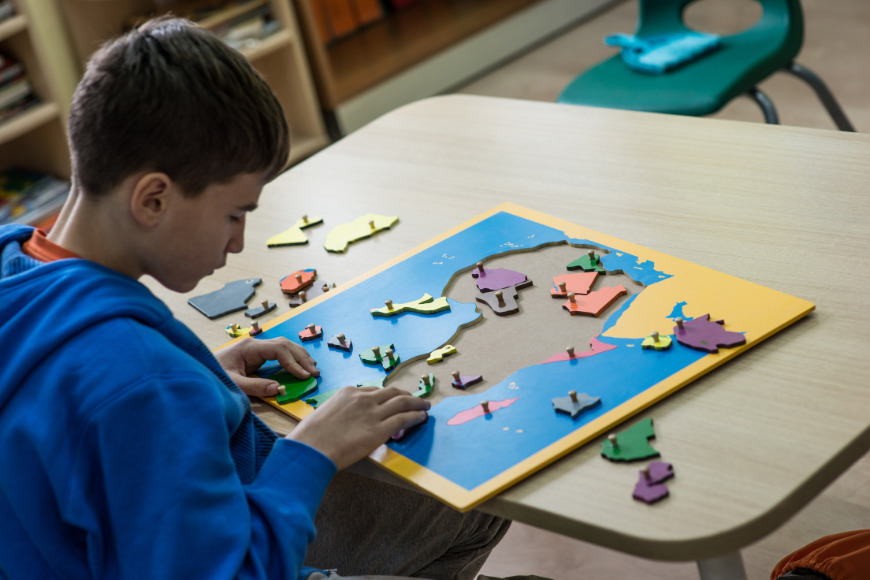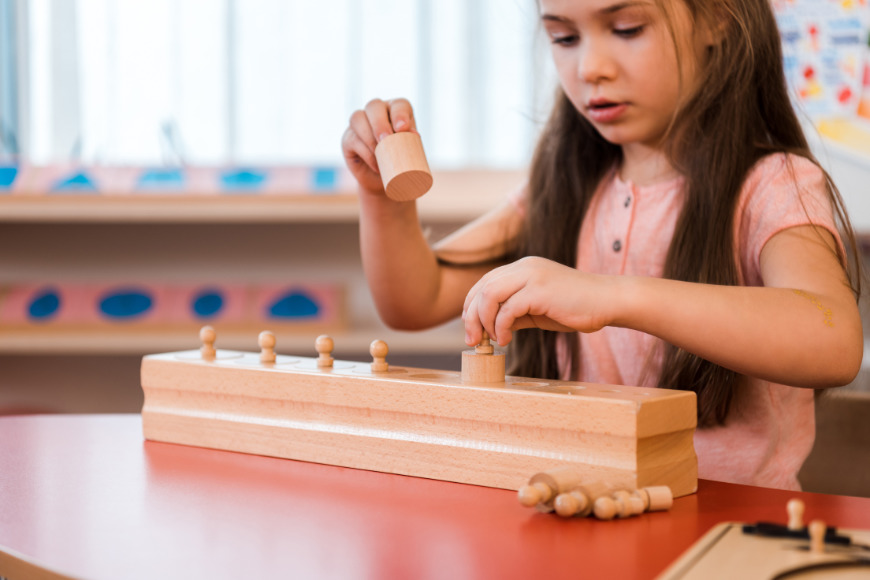How wonderful it is to know and understand that the entire world is a child’s classroom environment. When a child’s classroom learning goes beyond the four walls, the knowledge becomes infinite. And this happens in Montessori education.
Children, in the Montessori environment, learn to see themselves as global citizens and notice the splendor of varied cultures and traditions. They tend to see the world as their classroom. And with this approach, the Montessori Method fosters comprehensive cognitive skills in the children – imaginative thinking, problem-solving skills, and a desire to learn and challenge oneself.
What is Cognitive Development?
“The child’s development follows a path of successive stages of independence, and our knowledge of this must guide us in our behavior towards him. We have to help the child to act, will, and think for himself. This is the art of serving the spirit, an art which can be practiced to perfection only when working among children.”–Maria Montessori in the Absorbent Mind.
Cognitive skill is the ability of a person to approach problems and get solutions. The way we perceive, process, store, and use information is referred to as cognitive ability. (Bacanlı, 2001; Harrison & Rainer, 1992)
During early childhood, the children build the strategies of these aspects in individual ways and their performance capacities are measured with their thinking ability and not their skills. (Gander & Gardiner, 2001)
To develop cognitive ability, it is essential and advantageous that classroom curriculum should follow the pattern that fosters this development in a precise way and at the right age. It is important to provide the right foundation for the child’s success later in life.
What is The Montessori Theory?
The Montessori Method of Education is based on the guiding principles of freedom, order, choice, peer teaching, free movement, creativity, independence, self-correction, and intellect. Montessori principles, Montessori activities, multi-aged classrooms, and long work periods categorize the Montessori method (Lillard, 2006) that promotes cognitive development and nurtures the child as a responsible, thoughtful adult.
Maria Montessori believed that learning and growing are inseparable and created materials that use real actions and objects to translate abstract ideas into concrete form. Children in multi-age classrooms, learn by observing and interacting with these materials and peers. Long uninterrupted working periods help them concentrate and solve problems.
How do Montessori Education Foster Cognitive Skills?
Dr. Maria Montessori created instructional materials and a learning environment that cultivated the innate drive of the children to learn. The children are given the freedom to select their learning materials or activities from the shelf and long work periods help them explore and think more about solving the problem. In other words, a Montessori curriculum includes many such resources and activities that are helpful for cognitive development.
A child needs to get involved in day-to-day activities and interactions to stimulate cognitive development. Here are 5 aspects of the Montessori curriculum that play a key role in fostering the development of cognitive skills in children.
- The Prepared Environment: Montessori education helps the child internalize the surroundings and explore the materials around them. Children are motivated to learn when they are given materials that are appropriate for their skill development in a prepared environment which is essential for cognitive development. Constructive triangles, for instance, are presented for making varied shapes out of them. Brown stairs are used to let the child comprehend varied sizes.
- Critical Thinking: Books and hands-on learning materials available in the Montessori curriculum encourage critical thinking. Educators provide age-appropriate books and activities to children that foster cognitive development by increasing vocabulary and critical thinking. Sensorial and practical life activities help the child build semantic memory, concentration, and problem-solving skills. A child tends to attain higher critical thinking, which in turn fosters cognitive development in children.
- Interactions and Communications: Montessori education encourages cooperative play or imaginative role play among children of mixed-age groups. It is a seamless way to develop strong interactive skills as they interact, tutor, and learn together. The younger children get help from the older ones in their work, whereas the older ones refresh their concepts and develop leadership qualities. This endeavors the children for better self-construction and enhances brain development.
- Problem-solving ability: In a Montessori environment, children are encouraged to organize their thoughts, solve problems and learn new concepts at their own pace. The long work periods provide ample time to explore and learn the concept. They learn to take turns, follow directions, and build strategies. Children are also stimulated to recognize and correct their own mistakes. Development of such abilities lays the foundation of problem-solving, good-decision making, and analysis skills, which are part of cognitive development.
- Concentration: Montessori emphasizes side-by-side work, which fosters concentration in children as they develop new learning skills. Resource materials like transferring activities, color sorting activities, threading and sewing, and many such activities, help a child enhance focus and concentration. It also develops vocabulary and independence.
Impact of the Above Aspects on Cognitive Development
With the correct educational base and active education like Montessori education, the child is nourished with the understanding of the following:
- The children start to comprehend the surroundings.
- The more they understand the concept and the process, the more questions children ask. This improves their thinking abilities.
- Children find the logic behind the concept and build interest in the process.
- Children show interest in research, which improves vocabulary, problem-solving skills, and decision-making skills.
- Children also develop better social and emotional quotients.
Tips to Develop Cognitive Skills in Children
Apart from the resources that are offered in Montessori Classrooms, some basic tasks done with teachers or parents also foster cognitive development.
- Allow the children to make mistakes to help them learn better. Celebrate their success.
- Provide them with a variety of activities on a shelf. It promotes independence and decision-making skills.
- Children love to imitate adults. Invite them to do age-appropriate household chores such as cleaning leaves, folding clothes, and cleaning tables to build their autonomy and confidence.
- When introducing any activity, do not rush in with a solution. Let the child build interest and solve the problem at their own pace.
- Build a child’s vocabulary and interest by asking questions like “what happens next?”, “what is this?” or “how will we solve this problem?”.
- Introduce the child to open-ended activities and encourage them to solve problems with a different perspective.
- Expand the child’s interests by offering them books, crafts, games, or excursions based on their interests. For example, if a child is fascinated by cars, provide them with additional books, crafts, games, and excursions related to cars.
Final Words
Intellectual growth or cognitive development is enabled by freedom, structure and order, exposure to the surroundings, and a peaceful environment. When children are offered new tasks, lessons, and opportunities, they tend to develop not by remembering but by understanding.
Montessori education is well suited for the development of cognitive skills from early childhood days. In a Montessori classroom, not only features of basic education but also lessons in practical life, sensorial, language, art, science, culture, and music are all part of a diverse curriculum. These lessons are delivered in a progression from simple to complicated and from concrete to abstract. This fosters the development of cognitive skills rapidly.
References
- Courtier, P., Gardes, M.-L., Henst, J.-B. V. der, Noveck, I. A., Croset, M.-C., Epinat‐Duclos, J., Léone, J., & Prado, J. (2021). Effects of Montessori Education on the Academic, Cognitive, and Social Development of Disadvantaged Preschoolers: A Randomized Controlled Study in the French Public-School System. Child Development, 92(5), 2069–2088. https://doi.org/10.1111/cdev.13575
- Denervaud, S., Christensen, A. P., Kenett, Y. N., & Beaty, R. E. (2021). Education Shapes the Structure of Semantic Memory and Impacts Creative Thinking. NPJ Science of Learning, 6, Article 35. https://doi.org/10.1038/s41539-021-00113-8
- Denervaud, S., Gentaz, E., Matusz, P. J., & Murray, M. M. (2020). Multisensory Gains in Simple Detection Predict Global Cognition in Schoolchildren. Scientific Reports, 10(1), Article 1394. https://doi.org/10.1038/s41598-020-58329-4
- Gentaz, E., & Richard, S. (2022). The Behavioral Effects of Montessori Pedagogy on Children’s Psychological Development and School Learning. Children (Switzerland), 9(2), Article 133. https://doi.org/10.3390/children9020133
- Kayılı, G. (2018). The effect of Montessori Method on cognitive tempo of kindergarten children. Early Child Development and Care, 188(3), 327–335. https://doi.org/10.1080/03004430.2016.1217849
- Novak, M., & Schwan, S. (2021). Does Touching Real Objects Affect Learning? Educational Psychology Review, 33(2), 637–665. https://doi.org/10.1007/s10648-020-09551-z
- Osborn, E. (2022). The Effects of Cognitively Engaging Exercise on Children’s Executive Functioning [Master’s thesis (Action research report), St. Catherine University]. https://sophia.stkate.edu/maed/473
Should it Stay or Should it Go: When is it Appropriate to Introduce New Montessori Toys, Activities, and Tasks to Children?
A child’s engagement in play begins in infancy and benefits their development. When children play, they interact with the physical and social elements of the environment, allowing them to discover challenges and learn new skills. This enhances a child’s overall development, health, and well-being.
Sir Ken Robinson’s TED Talk, “Bring on the Learning Revolution,” presents the concept of a student-centered environment. It is much needed to provide a firm foundation in early childhood for the development of social, emotional, cognitive, and physical skills in order to encourage lifelong learning.
Children learn best when they are engaged in a variety of activities. But does it mean that we should provide them with a plethora of toys and tasks to learn with?
It is essential to understand the “what”, “why,” “when,” and “how” behind the rotation of activities and materials in Montessori schools so that you can apply it successfully at home.
What is a Toy Rotation and Why is it Important?
The concept of activity rotation refers to the provision of limited activities or toys placed on a front open shelf, which are focused on the development of a range of skills, and then replacing them with another set once that competency has been achieved. The rotation of toys can be done weekly, monthly, or seasonally depending on a child’s interest and skill achievements. It helps in decluttering the space and increasing a child’s concentration.
In an article titled, “The influence of the number of toys in the environment on toddlers’ play”, the authors explained observations from their study which indicated that when children are provided with fewer toys in the environment, they engage in longer periods of play with a focus to explore and play more creatively (Dauch et al, 2017).
The concept of activity rotation also aligns with Dr. Maria Montessori’s observation that children are benefited from a clean environment. She discovered that children in a calm, decluttered, and structured environment often engage for longer periods of time. Additionally, this improves the concentration of children and makes them more responsible and independent.
However, the concept of toy rotation is not officially derived from Maria Montessori’s research, but it does complement her findings.
“I then came to realize that everything about the child should not only be in order but that it should be proportioned to the child’s use and that interest and concentration arise specifically from the elimination of what is confusing and superfluous” by Dr. Maria Montessori in The Secret of Childhood
Montessori emphasizes minimalism, arranging fewer objects neatly on low shelves with space between them. Therefore, introducing too many toys overwhelms children, resulting in a loss of focus and interest.
Benefits of Montessori Resource Rotation
When introducing new Montessori activities, toys, or tasks to children, it is important to do it in intervals. This way, the child will not become overstimulated and will explore the new items with ease. The rotation of Montessori activities or toys allows children to keep engaged in a deeper way and spend more time exploring. It has many benefits, such as:
- It increases a child’s concentration and memory.
- It fosters creativity and independence.
- It helps children to become responsible and make the environment clean.
- It helps declutter the space and creates more area for a child to play.
- It doesn’t make children overwhelmed and reduces stress and anxiety in children.
- It provides more time for parents to spend time with their children.
When Should You Rotate the Activities for Your Child?
There is no right age to start activity rotation for your child. However, one can start toy rotation when a child starts to interact with toys on their own.
The Montessori Method focuses on letting the child lead. Therefore, introduce the child to 5-6 Montessori toys or activities at a time and observe their interest and development needs. Once the child excels in a skill or you can rotate the activities.
This toy rotation is generally recommended till the age of 6 years, which is the beginning of the second plane of development. At this point, children start developing an interest in hobbies like reading, writing, and mathematics.
How Often Should We Rotate the Activities or the Toys?
Each child has different developmental needs. A resource material that is the most attractive for one may not be liked by the other at all. Generally, in a Montessori school, a rotation of activities is done at different times for different children, depending on their developmental needs.
Educators understand the needs of every child by observation, as this allows the children to comprehend the tasks better. In the Montessori method, there is no set fixed duration when the toys need to be rotated. You can, however, rotate activities once every two weeks or once the child reaches the required skill set. Introduce children to open-ended activities or toys as it helps in fostering creativity and builds problem-solving skills.
The Montessori method offers a unique space for books and research, so along with toys, a child must be introduced to books from an early age. Once the child has mastered the knowledge in the book, it should be rotated.
Invite the children in to witness the changes once the space has been prepped. This helps in building their interest and excitement to explore and learn.
What Steps Should be Taken While Preparing For the Montessori Activities Rotation?
In the Montessori educational method, having fewer resources for a child is always better, as it is beneficial in many ways. Here are some tips and tricks to keep in mind while preparing for the resource or activity or toy rotation.
- Introduce a child to open-ended toys/ activities to start with.
- Do not introduce a child to more than 8-10 activities at a time.
- Keep the surplus activities in a closed closet or somewhere out of reach and view.
- Prepare a list of activities and sort them by categories like pretend play, gross motor, fine motor, sensory, practical life, and creative arts, etc before introducing activities and start the rotation process.
- Introduce activities that help children develop 3-4 skills at a time.
- Keep observing your children’s interests and development needs before introducing them to new activities. If not done right, you can end up in “lost interest” or “agitated behavior” or “too easy” situations.
- To build a child’s interest, introduce books and activities.
- There are no set rules–do rotate toys when it feels right based on your observation.
- Rotate activities based on festivals or events such as Halloween, Christmas, fall, spring, etc. to keep the child’s interest.
- Involve your child in the activity selection process when planning to rotate them.
For guidance on how to set up a Montessori environment at home, click here.
Final Words
The Montessori method emphasizes on promoting the concept of less is more. Therefore, it is important to introduce a child to limited activities, toys, and tasks appropriately and rotate them on a timely basis to meet the child’s development needs. If we do it too often, the child will become bored with the new toy and won’t be interested in it anymore. On the other hand, if we do not introduce them to new things frequently enough, then they will not be able to explore their environment or learn about what is around them.
Children are a bundle of surprises, and sometimes they may renew their interest in worn-out materials. They can return to the objects that an educator might feel are easy. Children pick up skills with repetition and they like discovering novel ways to play with their old favorites and that is why rotation is important.
References
- Administrator, H. (2019, August 20). Montessori at Home: The Secrets to Successful Toy Rotation | Hollis Montessori School, NH. Hollis Montessori School. https://hollismontessori.org/blog/2019/8/20/montessori-at-home-the-secrets-to-successful-toy-rotation
- Becker, J. (2014). Clutterfree with Kids: Change Your Thinking. Discover New Habits. Free Your Home. Becoming Minimalist.
- Cambre, M., & Hawkes, M. (2004). Toys, Tools & Teachers: The Challenges of Technology. R&L Education.
- Dauch, C., Imwalle, M., Ocasio, B., & Metz, A. E. (2018). The influence of the number of toys in the environment on toddlers’ play. Infant Behavior and Development, 50, 78–87. https://doi.org/10.1016/j.infbeh.2017.11.005
- Vig, M. (2020). The Holistic Guide to Decluttering: Organize and Transform Your Space, Time, and Mind. Fair Winds Press.
Why Sensorial Activities are Important for the Children’s Growth?
Learning begins at birth when a child observes through their senses (e.g., sight, taste, smell, hearing, touch). This is the reason why newborns respond to sound and touch. Sensory learning is a natural way for children to learn about their environment and from real-life experiences to develop problem-solving skills.
“The senses, being explorers of the world, open the way to knowledge. Our apparatus for educating the senses offers the child a key to guide his explorations of the world…” (Montessori, 1967)
Dr. Montessori’s insight into educating the child’s senses is a remarkable aspect of her method. According to her research, the five senses of taste, touch, sight, smell, and sound stimulate a child’s understanding of the physical, social, material, and natural worlds. Thus, experimenting with sensorial activities helps children comprehend information about their world.
This article discusses how sensorial play teaches children about their five senses and why it is important to incorporate them into the Montessori classroom. Finally, the article explains how to incorporate sensorial play into your home or life.
What is Sensorial Learning?
“Tell me, and I forget. Teach, and I remember. Involve me, and I will learn.”
This statement is attributed to Benjamin Franklin, and the sentiment applies to the early age of development.
Sensorial learning is a teaching method that stimulates a child’s five senses: touch, hearing, sight, taste, and smell. It includes activities that help them learn about colors, numbers, shapes, textures, object sizes, etc. It serves as a stepping stone to organized intelligence, allowing children to adapt to their environment. Sensorial exercises help children learn how to organize their environment, classify objects, and use logic in order to make sense of the world around them. It also teaches perspective, discrimination, and order.
For example, a child might be asked to identify an object by touching it or asking what food they think is based on its smell and taste. Sensorial learners are often more engaged than visual learners because they have more sensory input about the material being studied.
Benefits of Sensorial Activities to the Child.
- It helps children develop a rich vocabulary, explore their environment, and experience different textures.
- It helps them understand their own emotions through self-awareness and mindfulness.
- It teaches children how to focus on one thing at a time without being distracted by other distractions in their surroundings.
- It enhances a child’s ability to remember what they have learned by allowing them to learn through experience.
- It helps them build necessary skills that include cognition and logic.
- It builds nerve connections in the brain’s pathway by accomplishing more intricate tasks stimulating their senses.
- It helps develop social skills, gives them a sense of belongingness, develops their compassion, practices empathy, and enhances their communication skills.
Why do Sensorial Activities Play an Important Role in Montessori?
Sensorial activities play a crucial role in the development of the whole child. Children learn to perceive, interact, and experience the world around them and get prepared for success in higher education, life, and well-being. A Montessori classroom is designed meticulously to emphasize all five senses to introduce and develop everything that can be perceived. It helps prepare the children’s mathematical minds and encourages early language skills.
In a Montessori curriculum, sensorial activities are incorporated into all areas of learning. When compared to conventional education, Montessori education stands out because of its holistic approach to learning. Educating the whole child helps the school focus on all aspects of a child’s development, i.e., intellectual, emotional, physical, and social.
“Our work is not to teach but to help the absorbent mind in its work of development. How marvelous it would be if by our help, if by an intelligent treatment of the child, if by understanding the needs of his physical life and by feeding his intellect, we could prolong the period of functioning of the absorbent mind!” ― Maria Montessori, in The Absorbent Mind.
In a Montessori school, sensory play is set up in a prepared environment with controlled levels of error, so that children can safely explore and learn differences and similarities in their environment using their senses. It provides a child with an enormously rich sensory experience that promotes structured growth and development more than any other form of learning. Thus, helping children make connections in the brain increases memory and cognitive ability.
List of Montessori Sensorial Activities
Dr. Maria Montessori divided a child’s sensory learning into eight categories:
- Visual work– As the name suggests, the purpose of visual work is to help children categorize and notice the similarities and differences in objects they see. It includes discrimination to dimension (size, length, width, and breadth of objects), color (color awareness), and form (shape awareness). Activities included are:
- Dimension:
- Pink Tower,
- Brown Stairs,
- Knobbed and Knobless Cylinders,
- Red Rods, etc.

- Color:
- Primary Colors Box,
- Secondary Colors Box 2,
- Secondary Color Wheel,
- Value (Black, White, Gray) Color Tablets,
- Mixing Black and White, color Gradation Color Box 3
- Form:
- Tactile work- It focuses on enhancing the sense of touch to heighten their perception and understanding of the world around them. The purpose of tactile work is to help children develop the ability to discriminate between coarse and fine when they touch. Activities included are:
- Mystery Bags or Stereognostic Bags
- Matching Mystery Bag
- Rough and Smooth Touch Boards
- Rough and Smooth Touch Tablets
- Fabric Box

- Baric work- It aims to help children learn about pressure and weight. It helps them to understand the objects around them and think critically. Activities included are Baric tablets.
- Thermic work- The thermic activity aims to help children distinguish between temperatures and develop their sense of temperature. It includes hot and cold, warm and cool, and the relationship with the temperature of the child’s own body. Activities included are:
- Thermic Bottles, and
- Thermic Tablets.
- Auditory work- As the name suggests, this work helps a child in improving their sense of hearing. It helps children to differentiate between distinct sounds and heightens their ability to notice variations in sound. Activities included are:
- Montessori bells, and
- Sound cylinders.
- Olfactory work- The purpose of olfactory work is to develop the children’s sense of smell. It helps them to differentiate between distinct smells. Activities included are: smelling bottles.
Montessori Smelling Bottles - Gustatory work- It aims to help children explore their sense of taste (Is it sour, bitter, or sweet?). In these exercises, a child will learn to differentiate between a variety of food and taste. Activities included are:
- Tasting food prepared by various practical life activities, such as grating, slicing, and
- Tasting bottles.
- Stereognostic work – It is also known as tactile gnosis, the sixth sense, or muscle memory. The purpose of stereognosis work is to develop the tactile or the sixth sense by using a sense of touch. It helps a child increase the ability to recognize or characterize an object without using sight, sound, smell, or taste. Activities included are:
- Mystery bags,
- Painted and sandpaper globes,
Throughout the Montessori curriculum, multiple sensorial activities focus on descriptive language, recognizing, observing, categorizing, and matching patterns, etc. It not only helps a child improve their senses but also helps them to become independent and confident.
Why is it Important to Incorporate Sensorial Activities in a Classroom?
With unavoidable situations like the pandemic, more and more children are growing up in the digital era. We need to be concerned that they don’t have the opportunity to explore all of their senses. Thus, we, as parents and educators, should be responsible for providing them with a solid foreground for education. Providing more abstract education that focuses on physical and mental engagement from an early age is important.
Montessori sensorial play is learning that every child will love. Dr. Maria Montessori’s introduction focuses on training children into healthy, happy, confident, and independent adults. It allows them to build critical skills needed for their development and beneficial relationships with the world around them.
Sensory activities introduce complex, abstract concepts to children tangibly and experientially. Thus, this approach sets the foundation for all further academic pursuits and provides an incredible educational experience. It is a learning that children will carry through their life. The sooner children are exposed to different sensory activities, the better they will observe, understand, and process the information.
How to Incorporate Sensory Play at Home?
Incorporating sensorial work into your home can be done by creating an environment well-prepared where children can explore, learn, and understand their world through the five senses.
A sensory table is a great way to engage children with their environment and help them explore the world through their senses. It can be purchased online or made at home using various materials, as it is easy to prepare. These tables are great for helping children explore their world through the five senses of sight, sound, touch, hearing, and sense of taste. It is amazing what children will discover that they can do with these sensory tables.
You can also use those, as mentioned earlier, Montessori sensorial activities and incorporate them along with the regular activities prepared at home. For example, if a child is learning food preparation, you can add gustatory activities. If a child is learning to recognize objects, put miniature objects into a bag, make it a mystery bag, and ask them to put their hand in the bag and pick one object and ask them to guess the object they are holding, and so on.
Each of the Montessori sensorial play activities is easy to set up at home and is also fun. These activities allow children to identify objects with their senses while learning new ideas.
Final Words
In the coming future, a child’s development is not only about their brain. A child needs to grow with knowledge that lasts long, sensorial play benefits children because of its rich, abstract nature. Children enjoy their activities and develop their senses, cognitive skills, and overall growth.
References
- Montessori, M. (1967). The Discovery of the Child. Fides Publishers.
- Montessori, M. (1967). The Absorbent Mind (C. A. Claremont, Trans.). Holt, Rinehart and Winston.
An Introduction to the World of Montessori Education
Introduction
Early childhood education is a process that starts from birth and continues until the age of 8. This period is a crucial stage in the development of the child’s physical, intellectual, and social skills.
Thus, the importance of early childhood education cannot be overstated, as it helps children develop skills that will help them in their later years of schooling and their future careers.
Finding the right type of education for your child/children is a challenging and stressful endeavor. The pursuit to find the best education system for children depends on several factors, including teaching practices, the role of the educator, and classroom resources.
When considering Montessori education, parents may have misunderstandings or misconceptions. Currently, there are approximately 3,000 Montessori schools across the United States. Clearly, Montessori education has had a great impact on delivering successful teachings.
This article seeks to provide some clarity about Montessori education by providing a general explanation of its pros and cons. To provide some context, general information about its founder, Maria Montessori, is also included.
What is Montessori Education?
Montessori education focuses on educating the whole child (intellectual, physical, social & emotional development) by promoting individualized learning and focuses on a child’s interests, needs, and independence by providing children with opportunities to explore, learn, play, create, and discover.
Montessori education is based on scientific observations of children from birth to adulthood, where children pursue their own projects and choose what they want to learn based on what interests them. It is based on principles such as movement and cognition that are closely intertwined. The ability to direct one’s attention in a sustained environment fosters an array of positive development and many more.
Some of its unique features include preparing children to be independent in their daily chores, educating the whole child, hands-on learning, up to 3-hour blocks for activities chosen by children, a mixed-age classroom, skill-based materials, and curriculum.
Dr. Maria Montessori and the Foundation of Montessori Education
This educational philosophy was developed by and named after Dr. Maria Montessori, an Italian physician and educator who urged the importance of education in 1907.
During her research, she observed that children with age 3-6 years have distinct skill sets and knowledge as compared to older children who know how to follow procedures and make their own decisions about what to do next.
She took this opportunity and started a housing project in the San Lorenzo section of Rome, Italy, with 50-60 children aged 3 to 6 in January 1907. This building was named Casa Dei Bambini. It operates even today at the original location, at 58 Via Dei Marsi near the University of Rome (Kramer, 2017).
She viewed the classroom as a laboratory in which she understood how children learn best. As it was not a proper school, she furnished the classroom with small furniture specially designed for children. She also put in various learning materials that gave young teachers instructions on what to do.
Her observations during her visits and evening reports of teachers’ inspirations helped her create new materials for teachers. Dr. Montessori’s research continued for 45 years as she kept testing new approaches and materials and noting children’s reactions.
Her effort to understand a child’s learning behavior left a legacy of a broad, field-tested curriculum covering all the major subject areas-math, music, art, grammar, science, history, and practical life activities such as food preparation, daily household chores, and many more.
Montessori education was developed by experiments over her lifetime with children in places as diverse as Rome, India, Spain, the Netherlands, and the United States. Dr. Montessori even gave many lectures and wrote several books about her system for schools to follow. She then founded the Association Montessori Internationale (AMI) to carry on her work, including the training of Montessori teachers.
Montessori Theory of Child Development
Maria Montessori developed her theory of child development by observing and living with children in a school. While teaching, she observed how allowing children to choose their own learning activities enabled them to develop a deep interest in the activities they engaged in. These observations ultimately led to the development of what is now known as the “Montessori method” or Montessori education.
According to Dr. Montessori’s observations, children learn a lot by themselves and in groups. In her view, the best classroom design for any school is one in which children learn based on their developmental stages (3-year groupings) rather than in single-age groupings.
These stages of development are based on 2 basic principles:
- Children and adults can construct their own identities by reacting to their environments in different ways.
- Children have a natural, inborn path of psychological and physical development.
Besides supporting children’s development of physical and intellectual skills, these principles also enabled Dr. Montessori to discover how to provide opportunities for children to express social and emotional skills. Children can learn more efficiently by doing as they are allowed to observe, explore, discover, and create through real-life experiences with natural materials by Montessori educators.
As a result of these principles, she understands how children go through sensitive periods of learning and that each stage presents an opportunity for a particular skill set to be achieved.
Montessori 4 Phases of Development
Montessori education divides children based on 4 phases/stages of development. Each developmental phase has distinct characteristics and learning requirements.
- The first phase of development: Children aged 0-6 years fall into this category. It is the most critical stage of development. They are sensorial explorers, observers, and navigators of the concrete environment. It helps them refine their senses. During this stage of development, a child first gains language and then interests.
- The second phase of development: Children aged 6-12 fall into this category. These are children who learn to think logically in order to observe and understand the world. Groups of children often work together in order to achieve the end goal. This phase is an essential period for fostering social and emotional skills, intellectual independence, moral sense, and the initial stage of abstract thinking. Children at this stage are curious to learn new concepts and experiment.
- The third phase of development: Children aged 12-18 fall into this category. It is a time when children think abstractly in order to explore other perspectives or ideas. Children apply knowledge in real life and compete with the outside world. It is evident that they are capable of expressing themselves creatively, and their learning style is very unique. They now have reached the stage where they can choose more complex areas of learning and prepare themselves to be economically independent.
- Fourth and the last phase: Children aged 18-24 fall into this category. It is a time when individuals can synthesize their own experiences and ideas with cultural ideas and ideals or beliefs. It is the phase where adults are now independent, usually subsidize themselves financially, and lead society. Economic independence is also developed in this phase, as they no longer rely on their parents for financial security.
Pros and Cons of Montessori Education
In 2021, Forbes published an article on their website mentioning a study by Dr. Lillard, Meyer, Vasc, and Fukuda (members of the Department of Psychology, University of Virginia, Charlottesville, VA, United States). This study shows how Montessori education may be superior to conventional education methods and result in long-term benefits on psychological health and well-being.
Pros of Montessori Education
- Montessori education promotes self-motivated learning in a safe and structured environment–Montessori education focuses on developing one skill at a time using high-quality academic material that is child-friendly and active engagement to learn about the world around them. Montessori students are engaged in the learning process, making it more interesting and enjoyable.
- It provides children with opportunities to explore, learn, and play at their own pace, with no pressure from teachers or parents. In Montessori education, a child is placed at the center of learning and experience. They are provided with a variety of learning materials to choose, explore, and learn from. They are free to move around the classroom. The guides observe the child’s process of activity and only assist the child if needed.
- It creates a supportive environment in which children are encouraged to take risks and experiment with new ideas. A Montessori environment is well structured and prepared, keeping children’s developmental needs in mind to boost their learning process by exploring, and experimenting with activities. For example, while working with knobless cylinders, a child can also learn to use the combination of cylinders to create a pattern or a shape. Each activity is open-ended with a distinct harmony and purpose.
- Children are given the opportunity to learn about self-care, which is important for their future development as adults. Children, in Montessori schools, are provided with activities that help them do daily chores independently and engage in their own learning.
- The Montessori method fosters an individualized approach to teaching that can be adapted to students’ needs and stages. It lets the child take as much time as child needs to foster the skill by providing a child-like environment for them to learn with no limit. They can explore and learn at their own pace and build their own expertise.
Cons of Montessori Education
- There are an increasing number of public Montessori programs that exist in the United States and across the globe and these numbers continue to increase. However, most Montessori schools are private and require parents to pay tuition for their children to attend. Therefore, this can be one of the biggest hurdles preventing parents from enrolling their children in a Montessori school.
- Less availability of Montessori-accredited schools and learning environments. As per the American Montessori Society (AMS), only 15% of the private member schools are AMS accredited and the availability of public Montessori schools is also less than compared with conventional schools; making it difficult for children of low-income families to enroll in.
- The availability of Montessori materials in untapped areas is limited. In developing countries wherein education is still a privilege, it is difficult to find the right approach to education. In such countries, both the availability of Montessori schools and the Montessori materials are limited.
Final Words
The Montessori method, founded by Maria Montessori, is a system of teaching that has been proven to be effective for children as it aims to provide children with the materials or activities they need to thrive. It has been in use for over 100 years and is continuously growing in popularity all across the world. The method is based on the belief that children learn best by observing and experiencing the world around them.
The Montessori method is based on the development theory of children, where every child is unique and has their own needs. As a child grows into an adult, it shows how development needs to change. Thus, helping children boost their confidence, independence, responsibility, and creativity at every stage of development.
This approach is definitely a plus when parents want to provide the best learning experience for their children rather than rote learning. When deciding on your child’s education, one should consider all pros and cons of the environment as per the preferences and needs of your child. Be assiduous in your study to find the right kind of environment to help your child get the right beginning.
References
- Kramer, Rita. Maria Montessori: A Biography. New York: Putnam, 1976.
- Lillard, Angeline S., M. Joseph Meyer, Dermina Vasc, and Eren Fukuda. “An Association Between Montessori Education in Childhood and Adult Wellbeing.” Frontiers in Psychology 12 (2021). https://doi.org/10.3389/fpsyg.2021.721943.
How Does Montessori Education Help to Develop Semantic Memory at an Early Age?
Education is the central way to procure knowledge. Early childhood education is of the utmost importance as it not only forms a foundation for learning but it also affects the creative thinking, cognitive, and social and emotional development of children. During the early years, the environment plays a significant role in influencing and impacting the process of learning and knowledge acquisition.
Children learn concepts mainly through interactions with their surroundings – experiences. Keeping this in mind, a paradigm shift has been promoted by cognitive network science in recent years.
A study mentioned in the book: Education shapes the structure of semantic memory and impacts creative thinking, has examined how children’s education affects not only how they acquire new knowledge, but how they represent that knowledge in their semantic memory.
What is Semantic Memory?
Semantic Memory is a significant portion of long-term memory that stores information about evidence, happenings, philosophies, ideas, and concepts that are not drawn from personal experiences. It encompasses a wide range of topics, including historical and scientific details, mathematical equations and concepts, the knowledge that helps us to identify objects, the sound of letters, and other basic facts learned over a lifetime.
According to an article by Kimm Ann Zimmermann, the concept of semantic memory was introduced in 1972 after the collaboration between Endel Tulving of the University of Toronto and Wayne Donaldson of the University of New Brunswick on the impact of the organization on human memory.
In the article, she also discussed the study by Tulving mentioned in his book “Elements of Episodic Memory,” where he outlined the separate systems of conceptualization of episodic and semantic memory. Tulving noted that semantic memory differs from episodic memory in how they operate and the types of information they process.
Semantic memory comprises a long-term memory for meaning, understanding, and conceptual facts about the world. It is a memory that can be retrieved after a long delay (from several seconds to years).
In a more generalized form, knowing the meaning of something without having a familiarity with it from prior experience, or recalling the location and circumstances of a personal learning experience, is known as semantic memory.
For example:
The kiwi fruit may be well known to you: you know its appearance, its shape, its color, and how it tastes. Despite having knowledge of these details, you may have not actually seen or tasted the fruit. Your knowledge of the ‘kiwi’ fruit has been constructed through what you have seen, heard, or read about it. This is a semantic memory.
Development of Semantic Memory and Types of Encoding
Repetition and practice are the primary methods by which semantic memory is developed. Information is congregated by the senses and sent to short-term memory, where practice and repetition commit it to semantic memory’s long-term memory. The amount of repetition and rehearsal required to commit something to semantic memory differs from person to person.
There are 3 types of encoding done to commit the information to semantic memory.
- Visual – some people observe through pictures, or through reading words and numbers. The information in such a case is committed to semantic memory through visualization.
- Acoustic – when people commit the information through listening to the various facts again and again. Such information is committed to semantic memory through hearing or acoustic ways.
- Meaning – when people understand things and encode their meanings, the information is stored in semantic memory. This is how the meaning helps to commit information to semantic memory.
Children constantly learn new information every day. For them, it is easy to improve and exercise semantic memory through practice and hard work.
Benefits of Developing Semantic Memory
Semantic memory is of paramount importance for children because this is the memory that helps them to remember and recall the facts that they have learned subsequently. This memory allows us to know about the world around us better. It helps children answer: Is the sky blue? Are lemons yellow? Do dogs bark? The answer to these basic questions lies in semantic memory.
Semantic memory is of great importance for human beings as it helps us to navigate through day-to-day life.
A quote by Tulving stated, “If a person possesses some semantic memory information, he obviously must have learned it, either directly or indirectly, at an earlier time, but he need not possess any mnemonic information about the episode of such learning”.
Thus, it is the memory where all kinds of everyday functions, such as daily household chores, the ability to do things, safety points, communication skills learned in a particular language, and many such activities are stored, which we learned with experience.
It has also been shown in a variety of studies (specifically this one) that “associated abilities mediate the relationship between semantic memory structure and verbal creativity, implying the efficient spread of information in semantic memory may facilitate verbal creative thinking via associative abilities”.
Thus, semantic memory enhances children’s creative thinking, observation skills, and verbal skills.
How Does Montessori Education Help in Developing Semantic Memory?
Higher cognitive abilities, like creative thinking, depend heavily on how semantic memory is organized. Observing how knowledge representation is facilitated in children’s semantic memory is crucial to understanding how conventional educational methods and Montessori educational methods shape children’s learning and creativity.
According to a research study, “Education shapes the structure of semantic memory and impacts creative thinking,” the researchers showed that children who attended Montessori schools typically possessed a semantic network structure that was more supple than the structure possessed by those who were educated with traditional educational methods.
In other words, children educated with the Montessori education method typically have a greater number of neurological connections and a larger memory scale than children educated with traditional education methods. Also, children educated at Montessori schools scored higher on tests of creativity as compared to children from traditional schools.
How Does a Unique pattern of Montessori Education Impact Semantic Memory?
We discovered that differences in education had a significant impact on children’s creative thinking when it came to creativity. Children in Montessori classes scored higher on a variety of tests and studies than their peers in more affluent traditional classes.
Although both Montessori and conventional education can be of high quality, their approaches to concept learning differ. Concept learning is a crucial aspect of cognitive development that aids in the acquisition of new vocabulary and consolidated knowledge. Montessori education emphasizes concept learning more than conventional education.
When comparing Montessori and traditional educational approaches, Montessori classes have been shown to promote improved academic outcomes, socio-emotional learning, and divergent and/or convergent creativity. Environmental interaction plays an essential role in how children first learn about concepts.
According to previously mentioned research by Denervaud, S., Christensen, A.P., Kenett, Y.N. et al. which examined the role of education in the development of semantic memory, their results indicate that Montessori-educated children presented higher convergent and divergent creative skills than children from traditional classes.
This research also proved that when it comes to creative thinking, socio-emotional learning, and improved academic outcomes, the children from Montessori schools provide unique responses to those from traditional education.
Final Words
The Montessori Method has been shown to be successful in preparing children for future success in life (i.e., school, work, social relations, and other areas). The enhanced development of semantic memory afforded by the Montessori method is one reason why it is so successful in preparing children for future success.
What we learned from this study, and what is important to understand, is that the quality of learning is more fundamental than quantity. The more concepts are memorized with meaning, experience, involvement, pleasure, and personal understanding, the more they will be organized in memory in a flexible, diversified, and enriched way.
References:
- Denervaud, Solange, Alexander P. Christensen, Yoed N. Kenett, and Roger E. Beaty. “Education Shapes the Structure of Semantic Memory and Impacts Creative Thinking.” npj Science of Learning 6 (2021): Article 35. https://doi.org/10.1038/s41539-021-00113-8.
- He, Li, Yoed N. Kenett, Kaixiang Zhuang, Cheng Liu, Rongcan Zeng, Tingrui Yan, Tengbin Huo, and Jiang Qiu. “The Relation Between Semantic Memory Structure, Associative Abilities, and Verbal and Figural Creativity.” Thinking & Reasoning 27, no. 2 (2021): 268–93. https://doi.org/10.1080/13546783.2020.1819415.
- Nastase, Samuel A., and James V. Haxby. “Structural Basis of Semantic Memory.” In Learning and Memory: A Comprehensive Reference, edited by John H. Byrne, 133–51. Oxford, England: Academic Press, 2017. https://doi.org/10.1016/B978-0-12-809324-5.21073-0.
- Rosenbaum, R. Shayna, Alice S. N. Kim, and Stevenson Baker. “Episodic and Semantic Memory.” In Learning and Memory: A Comprehensive Reference, edited by John H. Byrne, 87–118. Oxford, England: Academic Press, 2017. https://doi.org/10.1016/B978-0-12-809324-5.21037-7.
- Schendan, H. E. “Semantic Memory.” In Encyclopedia of Human Behavior, edited by V. S. Ramachandran, 350–58. San Diego: Academic Press, 2012. https://doi.org/10.1016/B978-0-12-375000-6.00315-3.



